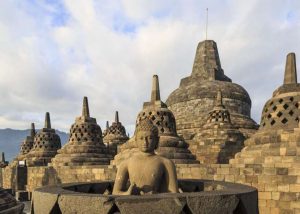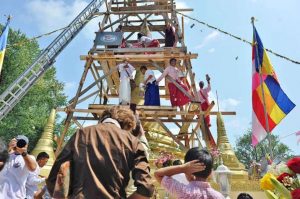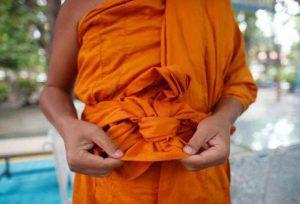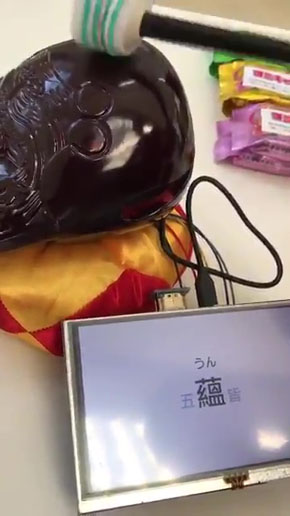
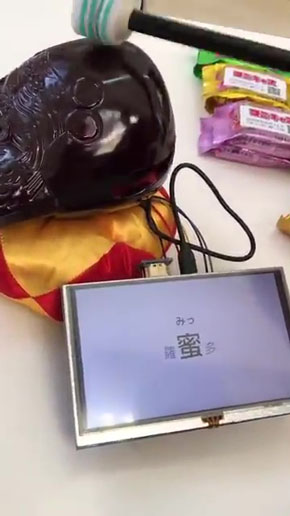
The digital mokugyo with syllables of the Heart Sutra in kanji and furagana. From nlab.itmedia.co.jp
Amid a marked decline in public interest in Buddhism in Japan, Buddhist temples are increasingly seeking to connect the country’s centuries old Buddhist traditions with modern technology in the hope of raising their popularity and making their services more available to the public. Temples have opened their doors to techno beats, and Softbank Robotics recently launched a robot priest to chant sutras during funeral services. For those who prefer their sutras to be read by human monastics and could use some help remembering the syllables of the Heart Sutra, developers have now come up with an updated version of the mokugyo (木魚, a traditional temple drum), which netizens have enthusiastically dubbed a “karaoke machine for the sutras.”
The mokugyo (木魚), which literally translates to “wooden fish,” is a traditional wooden percussion instrument used by Mahayana Buddhists during recitation. Monks or followers use a mallet to tap the mokugyo to create a cadence to which Buddhist texts, mantras, or sutras are chanted. Although the name seems to suggest that the instrument is made out of wood, it can also be made from other materials. In most Mahayana traditions, its distinct fish shape, however, can still be recognized. Originally shaped like an actual fish, which symbolized wakefulness in Buddhism as a fish never sleeps and reminds monks to focus on the text they are reciting, modern versions of the instrument are more stylized, often carved with fish scales or fish heads embracing a pearl.*
One of the most important sutras in Mahayana Buddhism is the Heart Sutra, which in Japanese reads as a series of short syllables following in close proximity to one another. Even the most devout monks or dedicated practitioners need to consult the text as they chant to ensure all the syllables are pronounced correctly and no section is skipped.
Keeping the rhythm of the drum and reading the Heart Sutra text at the same time, however, can be difficult, especially as one get further along the text. To accommodate those tapping the drum and having to read the sutra at the same time (for both monastics and lay people), developers have come up with a solution; a digital wood fish (デジタル木魚, dejitaru mokugyo). The fish drum is connected to a screen with a digital version of the Heart Sutra, and programmed so that with each tap on the fish the next syllable of the sutra appears on screen as kanji (漢字, traditional Chinese characters). They even included furigana** (振り仮名) above the kanji so that even people who might have trouble reading kanji can chant the Heart Sutra.
As one can see from the video below, three kanji appear on the screen with each beat, representing the current syllable in an extra large font in the middle (with its furigana reading above), the previous syllable in kanji in a smaller font on the left, and the next syllable in kanji in a smaller font on the right, as Japanese is read right to left.
According to Twitter user @tokyo_ff, who posted the first video of the digital mokugyo, the prototype is ready to be produced in small numbers and Buddhist monks are invited to test the prototype during their daily rituals.
The responses on social media to the digital mokugyo has so far been overtly positive, with some comparing the digital mokugyo to a karaoke machine for sutras, and asking for a similar smartphone application. There are hopes that the digital mokugyo will make the Heart Sutra, and with it Buddhist religious practices, more accessible to Buddhists across Japan.
Although about 75 per cent of Japan’s 127 million people identify as Buddhist, most seldom see the inside of a temple except for during traditional ceremonies to mark the New Year and funeral rites for deceased family members. Buddhism may be approaching something of a crisis point in Japan, with 27,000 of the country’s 77,000 Buddhist temples expected to close over the next 25 years, reflecting shrinking populations in small rural communities and a loss of faith in organized religion among the country’s population as a whole.***
* The Korean version is even more stylized, is more oblong in shape, and has no engravings.
** Furigana is a Japanese reading aid consisting out of kana (syllabic characters) next to or above a kanji character to indicate its reading. Furigana usually consists out of hiragana (one of the kana scripts used in Japan), but can also include katakana characters (second kana script used in Japan), or western letters (romaji) or other kanji.
*** Almost One-Third of Japan’s Buddhist Temples Expected to Close by 2040 (Buddhistdoor Global)
See more
Buddhist temples in Japan get digital upgrade with new techno wooden fish (Sora News 24)
「デジタル木魚」の響きが鮮烈 たたくごとに般若心経が少しずつ表示、読経の教材や音ゲーに応用できそう (Net Lab)


